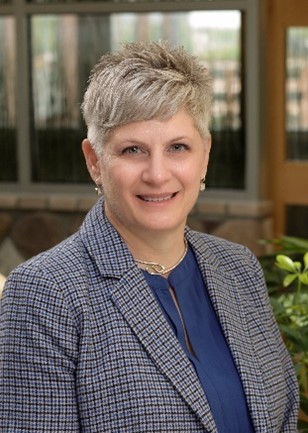Virtual Nursing: An Inside Look at Central Maine Healthcare
Kris Chaisson RN, BSN, MS, CCRN-K, NEA-BC, is the Chief Nursing Officer at Central Maine Healthcare where she oversees nursing and patient care services on behalf of Central Maine Medical Center, Bridgton Hospital, Rumford Hospital, and the health system’s ambulatory care locations.
Chaisson and the Central Maine Healthcare team recently launched a Virtual Nursing Program on the healthcare organization’s three hospital campuses. In a recent panel discussion co-hosted by nursing leaders from Caregility, Hicuity Health, and Blue Cirrus Consulting, Chaisson shared insight into her team’s experience with the new nursing model.
 Access the recording: Virtual Nursing: From Concept to Impact
Access the recording: Virtual Nursing: From Concept to Impact
You recently launched a virtual nursing program at Central Maine Healthcare. Can you walk us through the impetus for going the route of virtual nursing, which workflows you selected for the initial program, and why?

I think everybody can appreciate this nursing shortage and needing to find ways to help the bedside nurse, especially when 35% of our nurses have three years of experience or less. We were finding that they needed a little bit more support from experienced nurses so we decided to look at this route.
We initially engaged Hicuity Health in looking at this right at the height of the pandemic when we were taking care of critical care patients outside of the critical care area. We were having critical care patients in our ED, our critical care units were full, our PACUs were full, and we were wondering how we were going to do this with the expertise we needed. Once the pandemic sort of leveled out a little bit, we really shifted our focus and decided to look at how we could support the bedside nurse.
Most of the workflows we’ve used are really helping us with admission histories, medical histories in terms of medications, looking at discharge teaching, discharge education, and education throughout the patient’s stay. We recently started talking about using the virtual nurse to document for codes. That’s the next workflow we are going to look for, especially in our critical access hospitals.
You have a lot of novice nurses due to some of the turnover. How are you seeing this program assist the novice nurse?
I think they’re more comfortable with the technology and they haven’t had this established practice that they have to do everything by themselves. So, they’ve actually adopted it a little bit more readily than a more tenured nurse.
When a patient is boarding in the ED for a little bit and comes up to the floor and all their admission history and medication history is done, it’s a sense of relief that now they can spend time just meeting the patient, talking to them, doing their physical assessment, and developing that relationship instead of worrying about the tasks that need to happen. So, they’ve embraced it.
How did you work to establish trust between the staff on the floor and the nurses that are supporting them virtually?
We really worked at that. The implementation team did a little team building and orientation with the virtual nurses, just to get to know them a little bit and really be inspired by how much experience they have to bring to the bedside. And then we really worked hard on the handoff, sort of scripting an introduction of the virtual nurse to the patient. So, there was trying to manage learning who they are, what they can do, and then have [bedside staff] really treat [virtual nurses] as an extension of our team. And I think that really helped the nurses see that they were really helping and not something to fear.
We eased into this with the virtual nurse. We were comfortable with the camera because we do have a virtual patient safety assistant program. They were kind of used to the traveling video camera, going from room to room to help care for patients in that way. So that was less of a hurdle for us because we had that foundation.
Getting folks engaged really early on was really important. We also launched a survey to the nurses before we started, asking them what would help them. What do they find takes the most time out of their day? And then we wanted to make sure we didn’t just put a cookie-cutter sort of solution on top of a problem we thought we were fixing, but really didn’t need to. So that was really helpful.
What are best practices around insourcing versus outsourcing the virtual nursing staff?
What was most helpful working with Hicuity is we asked to talk to a few clients who had already been there, done that, and got to learn from them and ask, “If you had to do it all over again – what wouldn’t you do?” That way, we wouldn’t step in those potholes that they did. That was very helpful.
We did entertain whether or not this was something we could take on ourselves and we quickly came to the decision that we don’t have the nursing supply here in Maine. We rely heavily on purchased labor. This was cheaper than purchased labor, so we were excited about that.
Now I would be lying if I didn’t admit I thought, “Wouldn’t this be awesome in the future as the nurses here age and can’t be at the bedside anymore? Is this an opportunity for us to build in some retention for our tenured nurses to be able to do this remotely at home?” And that’s crossed our minds, of course, because I do need to have a long-term strategy for that game.
What are some of the things that you’re going to measure for success in your program?
We’re going to resurvey the team. We’re also looking at our nurse-sensitive indicators to see if they’ve helped. We have a dashboard on our portal page where we track all the assignments that the virtual nurse has done through Cerner. So, we have a tally of how productive we are in that realm.
We’re also looking at our quality metrics and then any event that they sort of head off at the pass. So, if they notice somebody that’s not doing very well and they cue in the nurse and we save a code from happening or, say, help with a rapid call, we’re going to track that too on our risk-tracking system.
If there was one thing about the perceptions of virtual tools and virtual nursing at your organization that you could change, what would it be?
I would try to take the fear out that we are replacing nurses with this. I think there was a fear there when we first started talking about it because our scope was big – like adding maybe a virtual nurse on every floor and maybe we could downsize a nurse but add more CNAs. And then we quickly learned that wasn’t going to be right for our organization or culture. We had to really shift gears and think, “How do we support them?” It’s supportive and it’s not replacing a nurse. And I think that went a long way.
We also started very small. We have 24 hours of nursing care coverage by a virtual nurse. We have a nurse coming in at 7:00 in the morning and leaving at 7:00 at night and one coming in from 11:00 AM to 11:00 PM. That’s 24 hours of care. We picked those hours because that’s when you ramp up in your admissions throughout the day. We’re going to start there, and we want to see how that goes and whether we need to expand or cut back or adjust hours a little bit. But we started slow and small to get people used to it and it is going really well.
What advice would you give anyone who is trying to implement a virtual nursing program?
I wish I had somebody to tell me how to do it. You really need to know your data. You need to know your nurse turnover. You need to know the experience of your nurses. You need to know what the skills and the pain points are for them.
And then you need to put that proposal together and get real support from your executive team because there is a financial investment you have to put in upfront. There is some technology. We had to sign a service agreement with the company to get the nurses. And we had to say, “Okay, if we do this, we’ll get this.” So, we put together a very robust business proposal to get buy-in from them. That was really the first step.
I had already kind of circulated it through the nursing leadership team… but getting the senior team to really buy in as being a partner with nursing to support this [was vital]. I needed every member from finance to HR to understand. Because, as you can imagine, HR was going to get questions like, “What’s going to happen with my job? Do I still have a job?” Those sorts of things. So, getting support from those stakeholders was really key.
And then really engaging your key stakeholders. We had a plethora of different services from patient experience to infection prevention, transport, and environmental services all engaged in this process to make sure that we went through all the steps you need to in change management. IT had their own project manager. We had Kaitlyn Smith, who helped manage the project from the nursing clinical side. So that was a great partnership. And then we had both Caregility and Hicuity Health facilitating those meetings as well and it was a great partnership to get this launched.
Considering Virtual Nursing for your healthcare organization? Schedule a call with our experienced team of clinical program managers and virtual care implementation experts today.







